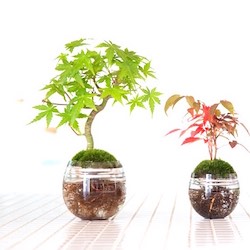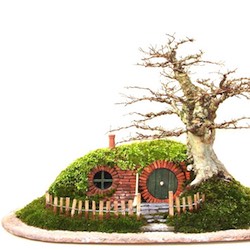Although Bonsai is the art of growing miniature trees, I have always been fascinated by Bonsai that are on the large side. Shohin and Chuhin size Bonsai do very little for me.
Shohin and Chuhin may be cute, but to me they do not have the power and majesty of larger Bonsai. They do not grab me in the same way that large Bonsai can do. But of all the species commonly used for large Bonsai. none are as impressive as the Trident maple -i.e. Acer buergerianum, and none are as easy to develop in a short space of time as the Trident.
My first encounter with Trident maple bonsai trees dates back to the early 1970s when a couple of UK Bonsai nurseries first started importing Tridents. Most of them were just small plants costing very little, but there were a few with trunks of around 4" (10cm) diameter which fascinated me. About that time, I purchased one such tree and made quite a few cuttings from it. By planting the cuttings in open ground, I was surprised to find that they could grow into large trunk trees with trunks of 4" (10cm) diameter in just four or five years! But it wasn’t until I started my own nursery in the mid 1980’s, that I started experimenting with Tridents seriously. On my buying trips to Japan, I was able to pick Tridents of all sizes to grow into the styles and shapes that I liked. Once I got the taste of the Trident maple, I began to experiment with the development of good Surface roots, or Nebari, taper and ramification at my nursery in Surrey.
This is what we aim to achieve; a Bonsai with a thick tapered trunk.
In 1990, on one of my regular trips to Japan, I came across some very thick Trident stumps that were being sold quite cheaply. They had no taper or branches at all, - hence the cheap price. There were about twenty of these stumps. They were so ugly that no customers were interested in them, which was all the more reason that I was determined not to sell them. I grew them on in our nursery in large training pots but not in the ground. They continued to grow on year by year and the trunks got progressively thicker and branches would sprout from all over the trunks.
Although growth is prolific with Japanese maple Bonsai –getting branches to sprout from just the right places is not that easy. Nor is the creation of good taper and nebari. What I discovered in the twenty or more years that I have been experimenting with Tridents is worth sharing with you.
There are four distinct phases in developing large size Tridents:
- Developing the thick trunk
- Developing a good trunk taper
- Developing good nebari or root base
- Developing branches and ramification
Developing the Trunk (trunk thickening)
There is no substitute to growing in the open ground in order to get a thick trunk. If you plant a cutting in open ground, you will get thickening in a very short space of time. There is just one drawback to open ground cultivation and that is the development of the tap root. If the tree is left unchecked, the tap root goes straight into the ground and very little surface root will develop. To overcome this, you can either lift the tree out once every three or four year and cut the tap root back, or grow the tree over a paving slab or flat stone to prevent the tap root from going right down into the soil. Lifting the tree out of the ground every three or four years will also give you the chance to cut the thick roots back so as to encourage fine feeder toots to develop. Grow the tree in good rich soil as this will considerably speed the growth rate.
Once the desired trunk thickness has been achieved, the tree should be cut down to the desired height or the top air-layered to begin the next stage of training. It is at this stage that the tree should be lifted from the ground and planted into a large container or training box.

The trees growing in open ground.

A tree ready for the next phase; developing taper.
Developing the Taper
I find that developing a taper is best done when the tree is transferred into a container. Encourage branches to grow unchecked and select a strong upward growing shoot to grow as the leader. Let this grow uncheck as well. With a strong growing tree, the leading shoot can grow 3-4 meters in one growing season. The process of developing the taper is probably the most difficult part of growing a nice specimen Trident. You have to let the leader grow unchecked each year and cut the leader back to 4-6" (10-15cm) each time. This is what I call adding taper. Over a period of time the taper will merge nicely with the rest of the trunk.
Some of my big Tridents have taken nearly twenty years to get good taper . Each year the leader is allowed to grow long and then cut back to 4" (10cm) or less of the new growth. By adding to the taper in this way, you will eventually get excellent taper. This part of the process cannot be rushed!

The top branch is the leader branch, which helps create taper in the trunk.

Hollowed trunk, called Uro.
Developing the Nebari or Rootage
This is another slow process because good nebari takes time. Begin by growing the tree in a large but not too deep training pot. As the tree grows, tease out the roots so that they spread out radially. Avoid all crossing and ugly roots and make sure all the roots are at at the same level. Planting the tree in a large but fairly shallow box will force the roots to stay at the surface instead of forming deep tap or anchor roots. If the surface roots are poor, you can graft young Tridents plants to grow up the trunk. As Tridents are fast growers, new grafted roots will not take long to get established.

A low branch bended downwards, to create a thick root.

Young shooting to become a main surface root, to fill a 'hole' in the nebari.
Developing Branches
Encourage only those branches that are in the right place to create a good branch structure in your Bonsai tree. Anything else that grows in the wrong position – you should remove. Also, if you need branches in another position, you can easily grow a long shoot or branch and in- arch that shoot to graft it into position.
I like my Tridents to have long spreading branches, that is why my Tridents have a large branch spread. The pictures here show how some of these branches have been developed.

Attaching a long young shoot to make a new branch.

See how this branch has been in-arched by grafting a branch into another position.
The end result; Maple tree with a thick, tapered trunk with a stunning nebari and branch structure.
Written by: Peter Chan. "Author of several Bonsai books, winner of many awards and owner of Heron's Bonsai in the UK. Peter Chan is an expert at Bonsai and japanese gardening.". Please visit his site herons.co.uk for more information, or check his Bonsai artist profile; Peter Chan.






